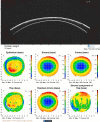Focused ultrasound in ophthalmology
- PMID: 27757007
- PMCID: PMC5053390
- DOI: 10.2147/OPTH.S99535
Focused ultrasound in ophthalmology
Abstract
The use of focused ultrasound to obtain diagnostically significant information about the eye goes back to the 1950s. This review describes the historical and technological development of ophthalmic ultrasound and its clinical application and impact. Ultrasound, like light, can be focused, which is crucial for formation of high-resolution, diagnostically useful images. Focused, single-element, mechanically scanned transducers are most common in ophthalmology. Specially designed transducers have been used to generate focused, high-intensity ultrasound that through thermal effects has been used to treat glaucoma (via ciliodestruction), tumors, and other pathologies. Linear and annular transducer arrays offer synthetic focusing in which precise timing of the excitation of independently addressable array elements allows formation of a converging wavefront to create a focus at one or more programmable depths. Most recently, linear array-based plane-wave ultrasound, in which the array emits an unfocused wavefront and focusing is performed solely on received data, has been demonstrated for imaging ocular anatomy and blood flow. While the history of ophthalmic ultrasound extends back over half-a-century, new and powerful technologic advances continue to be made, offering the prospect of novel diagnostic capabilities.
Keywords: Doppler imaging; high-intensity focused ultrasound (HIFU); ophthalmic ultrasound; ultrafast imaging; ultrasound biomicroscopy (UBM).
Conflict of interest statement
Dr Silverman has a commercial interest in Arcscan, Inc. The author has no other conflicts of interest to declare.
Figures








Similar articles
-
Ultrafast Ultrasound Imaging of Ocular Anatomy and Blood Flow.Invest Ophthalmol Vis Sci. 2016 Jul 1;57(8):3810-6. doi: 10.1167/iovs.16-19538. Invest Ophthalmol Vis Sci. 2016. PMID: 27428169 Free PMC article.
-
High-resolution ultrasound imaging of the eye - a review.Clin Exp Ophthalmol. 2009 Jan;37(1):54-67. doi: 10.1111/j.1442-9071.2008.01892.x. Epub 2008 Dec 9. Clin Exp Ophthalmol. 2009. PMID: 19138310 Free PMC article. Review.
-
High-frequency ultrasonic imaging of the anterior segment using an annular array transducer.Ophthalmology. 2007 Apr;114(4):816-22. doi: 10.1016/j.ophtha.2006.07.050. Epub 2006 Nov 30. Ophthalmology. 2007. PMID: 17141314 Free PMC article.
-
Peering into the eye: A comprehensive look at ultrasound biomicroscopy (UBM) and its diagnostic value in anterior segment disorders.Indian J Ophthalmol. 2023 Aug;71(8):3118-3119. doi: 10.4103/IJO.IJO_608_23. Indian J Ophthalmol. 2023. PMID: 37530300 Free PMC article.
-
Sophisticated instrumentation and ophthalmic ultrasonography.Acta Ophthalmol Suppl (1985). 1992;(204):18-21. doi: 10.1111/j.1755-3768.1992.tb04917.x. Acta Ophthalmol Suppl (1985). 1992. PMID: 1332387 Review.
Cited by
-
Detection and Diagnosis of Retinoblastoma: Can Mobile Devices Be the Next Step Toward Early Intervention?Cureus. 2022 Oct 8;14(10):e30074. doi: 10.7759/cureus.30074. eCollection 2022 Oct. Cureus. 2022. PMID: 36381807 Free PMC article. Review.
-
Imaging of Uveal Melanoma-Current Standard and Methods in Development.Cancers (Basel). 2022 Jun 27;14(13):3147. doi: 10.3390/cancers14133147. Cancers (Basel). 2022. PMID: 35804919 Free PMC article. Review.
-
Integrating a Fundus Camera with High-Frequency Ultrasound for Precise Ocular Lesion Assessment.Biosensors (Basel). 2024 Feb 29;14(3):127. doi: 10.3390/bios14030127. Biosensors (Basel). 2024. PMID: 38534234 Free PMC article.
-
Comparison of ultrasound cycloplasty and transscleral cyclophotocoagulation for refractory glaucoma in Chinese population.BMC Ophthalmol. 2020 Sep 29;20(1):387. doi: 10.1186/s12886-020-01655-y. BMC Ophthalmol. 2020. PMID: 32993561 Free PMC article.
-
Ultrasound cyclo-plasty for moderate glaucoma: Eighteen-month results from a prospective study.Front Med (Lausanne). 2022 Dec 16;9:1009273. doi: 10.3389/fmed.2022.1009273. eCollection 2022. Front Med (Lausanne). 2022. PMID: 36590936 Free PMC article.
References
-
- Panda PK. Review: environmental friendly lead-free piezoelectric materials. J Mater Sci. 2009;44(19):5049–5062.
-
- Mundt G, Hughes W. Ultrasonics in ocular diagnosis. Am J Ophthalmol. 1956;41(3):488–498. - PubMed
-
- Oksala A, Lehtinen A. Diagnostic value of ultrasonics in ophthalmology. Ophthalmologica. 1957;134(6):387–395. - PubMed
-
- Jansson F, Sundmark E. Determination of the velocity of ultrasound in ocular tissues at different temperatures. Acta Ophthalmol (Copenh) 1961;39(5):899–910. - PubMed
Publication types
Grants and funding
LinkOut - more resources
Full Text Sources
Other Literature Sources

